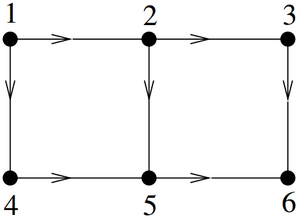Science:Math Exam Resources/Courses/MATH307/April 2013/Question Section 201 06 (a)
{{#incat:MER QGQ flag|{{#incat:MER QGH flag|{{#incat:MER QGS flag|}}}}}}
• Q1 (a) • Q1 (b) • Q1 (c) • Q1 (d) • Q2 (a) • Q2 (b) • Q2 (c) • Q2 (d) • Q2 (e) • Q2 (f) • Q3 (a) • Q3 (b) • Q3 (c) • Q4 (a) • Q4 (b) • QS201 5(a) • QS201 5(b) • QS201 5(c) • QS201 6(a) • QS201 6(b) • QS201 6(c) • QS201 6(d) • QS201 7(a) • QS201 7(b) • QS201 7(c) • QS202 5(a) • QS202 5(b) • QS202 5(c) • QS202 5(d) • QS202 6(a) • QS202 6(b) • QS202 7(a) • QS202 7(b) • QS202 7(c) • QS202 7(d) • QS202 7(e) •
Question Section 201 06 (a) |
|---|
|
Consider the same graph as in the previous question, now interpreted as an internet where the vertices represent web pages and the arrows represent links. (a) Write down the stochastic matrix associated with the PageRank algorithm with no damping. Explain what you are doing with vertex 6. |
|
Make sure you understand the problem fully: What is the question asking you to do? Are there specific conditions or constraints that you should take note of? How will you know if your answer is correct from your work only? Can you rephrase the question in your own words in a way that makes sense to you? |
|
If you are stuck, check the hint below. Consider it for a while. Does it give you a new idea on how to approach the problem? If so, try it! |
Hint |
|---|
|
Suppose when on page i, that one can move to all pages i points to with equal probability. You are looking for the transition matrix, where component i of the state vector on which the matrix acts represents the probability of being at webpage i. |
|
Checking a solution serves two purposes: helping you if, after having used the hint, you still are stuck on the problem; or if you have solved the problem and would like to check your work.
|
Solution |
|---|
|
When = 0, The stochastic matrix P is the sum of the outgoing links and the dangling links:
Vertex 6 has no links leaving the site, so it is a dangling node. When the web surfer reaches a dangling node, we assume that any page on the internet can be chosen at random with equal probability. This is why all the entries in column 6 of matrix P contain the value 1/6. |
{{#incat:MER CT flag||
}}



